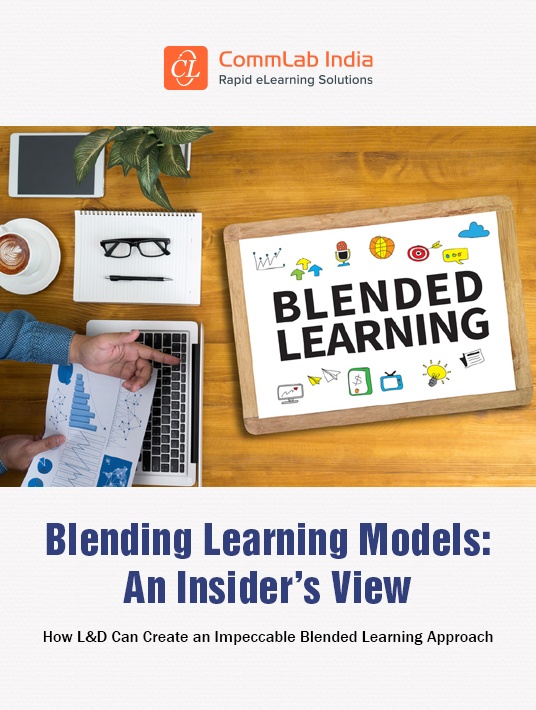Best Practices To Save Employee Training Costs With Blended Learning
Although a blended learning strategy promises many financial benefits over a one-size-fits-all strategy, poorly-designed blended learning can actually result in the opposite: more cost for an ineffective blended learning strategy!

We came up with these 6 blended learning best practices in a bid to identify cost-effective strategies for the implementation of blended learning, after diving into journals, consulting with clients and industry experts, and digging into our own experience designing blended learning solutions.
1. Evaluate Learning Material For The Online Format
One of the first things to do when implementing blended learning is to take stock of all the learning material you have—ILT material, paper-based materials used as source material for ILT—and see which components you wish to move online. Taking stock of all the available material saves a lot of time and, therefore, money.
When you have a clear idea of what to include in the classroom and what in the online component of your blend, implementation becomes much easier and less challenging.
Here are the steps to conduct a thorough content assessment for your blended learning strategy [1]:
- Take complete stock of the inventory; identify the training material that already exists.
- Review existing content with the help of your Subject Matter Experts (SMEs) and see if it’s adequate to meet the learning objectives.
- Determine which components need to be enhanced or updated to make them online ready.
- Decide what new content needs to be created to bridge any gaps identified in the existing content.
2. Base Your Design On The Learning Objectives, Not Specific Technologies
Blended learning is not simply about using technology to engage learners; it’s about using technology to achieve the desired learning outcomes and learning objectives (i.e., what is to be learned and what learners will be able to do after the training).
While designing your blended learning, keep in mind the learning objectives of your training along with learner demographics, not just the latest technology. In fact, use them as a roadmap for designing your blended learning strategy, aligning the content, assessments, and activities for the most optimal learning experience.
What does blended learning aligned with the learning outcomes look like?
First, let’s understand that there is more to online learning than just eLearning. There are plenty of other online formats you can use as part of your blended learning.
Example
Consider the learning outcomes of product training, for example.
Training about a company’s products is offered to the company’s sales and service personnel. Along with selling skills, it’s also important that sales and customer service reps are fully informed about the products they talk about to customers.
The learning outcomes, here, are to enable the sales reps to:
- Identify and describe the features and benefits of different products
- Use selling skills to make a sale
- Answer customer questions and overcome their common objections
Here’s how to tailor the blended learning to achieve the above learning outcomes:
- Create a live video of an expert demonstrating the working of the product. This works much better than just describing the product’s features; offer self-paced, simulation-based courses for practice.
- Use a combination of Instructor-Led Training (ILT) and online learning to teach communication skills effectively [2]; ILT can be used to share best practices of selling and negotiation skills while the online component can be used to offer learners opportunities to practice their skills through scenario-based modules.
- Make learning collaborative; engage learners in role-playing and discussions, or host message forums/chat rooms on the portal or LMS.
3. Consider Microlearning For The Online Component
Employees, especially "mobile" learners, tend to be disengaged from training unless it is short and reinforced at spaced intervals. To address the learning needs of the modern workforce with short attention spans, use a curriculum of microlearning modules instead of a full-fledged [3], lengthy eLearning module in your blended learning.
Microlearning is not just about slicing and dicing the content to make it bite-sized; each microlearning module is its own little standalone learning module of a few seconds to 15 minutes or more, dealing with one learning objective—short enough for learners to retain the information and use it to improve their work performance.
What’s more important is that microlearning is one of the most cost-effective online learning solutions because its modular nature and multi-device support enable the creation, rollout, or update of digital content at break-neck speeds.
Some of the microlearning formats include videos, PDFs, gamified nuggets, infographics, quizzes, podcasts, whiteboard animations, and scenario/simulation/game-based assessments.
Here’s how microlearning can be used as one of the blended learning best practices:
- Pre-training
Introduce basic concepts via microlearning videos or case studies; use classroom sessions for discussions and brainstorming. - During training
Augment classroom sessions with short learning videos and infographics; the instructor can demonstrate complex processes and procedures using these microlearning assets along with personal anecdotes from experiences in the field. - Post-training
Provide performance support after the completion of the training [4]. For example, the Q&A session at the end of the classroom session can be turned into micro FAQ modules; conventional quick reference guides can be turned into "how-to" micro-demo videos or simple explainers.
4. Leverage Rapid Authoring Tool Templates For Quick Development
What makes blended learning a cost- and time-efficient strategy is that eLearning can be rolled out rapidly, thanks to the rapid authoring tools.
Rapid authoring tools are eLearning development tools having their own set of ready-to-use templates and media libraries. Some popular rapid authoring tools for eLearning development include:
- Articulate 360
- Adobe Captivate
- Lectora Inspire
- iSpring
The templates offered by these tools can be customized to meet your project requirements. You can have standardized templates for the GUI, introductory slide/s, summary, assessments, and more, to be reused across courses. This saves valuable development time and money because you don’t have to spend time creating and recreating courses from scratch.
Here’s a short evaluation of the authoring tools and their features for eLearning development:
| The tool |
What it offers |
| Adobe Captivate | Ability to:
|
| Articulate Storyline |
|
| Lectora Inspire |
|
| iSpring |
|
5. Evaluate The Online Component With A Pilot
All of us are familiar with the television pilot, a standalone episode that is used to sell the show to a television network or audience.
Wondering why this is relevant? Could this be one of the blended learning best practices? Well, when you’re getting started with online learning, you also need a trial/pilot run before the courses are fully launched. A pilot run is used to test the technology, instructions, content, activities, and User Experience so that any problems can be fixed before the final launch.
It serves as a warning system for Instructional Designers about which elements work well and which don’t. It helps you gain stakeholders’ interest and support, on the time-cost benefits of converting high-visibility courses (such as compliance training) to eLearning [5].
It helps you identify problems related to:
- Inconsistencies in design elements
- Problems with scroll and navigation
- Compatibility with browsers and devices
- Broken hyperlinks and social media widgets
It can also help you assess the demands, especially those of medium and long-duration, that online courses may have on your employees. It can help determine the offline support tools necessary to help learners have a smooth learning experience.
Here are 5 tips on how to pilot your online learning:
- Develop key questions on what you’re hoping to find during the pilot run.
- Get your data collection instruments and methods in place—they may include surveys, interviews with testers, or a combination of both.
- Determine the length of the pilot; will it be a one-day event or spread across days/weeks?
- Select your audience to represent the full spectrum of the workforce for whom the training is being designed.
- Allow the sample group to test the course/s in different locations to get a fair idea of the bandwidth and internet most learners will have access to.
6. Decide Between Developing eLearning Inhouse Vs. Outsourcing
Does your internal team have the expertise to develop eLearning and, more importantly, do they know how to make the most of rapid authoring tools to scale up/down the development process to save time and cost?
You need to have answers to these questions right at the start of the blended learning project. If your internal team is not up to the task for whatever reason, consider outsourcing the eLearning development as one of the blended learning best practices.
What benefits does outsourcing offer over in-house development?
When you outsource your online learning development, it will go into the hands of an expert team of Instructional Designers, authoring tool experts, quality assurance analysts, project managers, and narrators who will ensure your courses are developed in the most cost- and time-efficient manner.
Here are all the benefits you can enjoy by hiring a vendor to develop online learning for your blended learning strategy [6].
- Instructional Designers with expertise in ID and adult learning principles will design the courses.
- Experienced translators and narrators will carry out eLearning translations.
- Microlearning assets such as interactive PDFs, infographics, eBooks, or mobile apps will be created.
- The tried-and-tested Project Management processes of the vendor will help scale up the conversion project as and when required while keeping it within budget and timelines as much as possible.
Apart from these, a good vendor will also:
- Conduct a Training Needs Analysis to assess your training needs and offer a tailored experience to your learners
- Ensure that the blended learning strategy is aligned with your business goals and requirements
- Help identify the ideal formats and strategies for your blended training requirements
- Provide administrative and maintenance support in terms of content updates and learning analytics
As you can see, blended learning is more than just using technology to reach and engage learners. It needs a carefully crafted management and execution plan to get blended learning right. If you wish to do it right in the most cost-effective and time-efficient way, follow the blended learning best practices discussed.
Download the eBook An Insider's View On Blending Learning Models: How L&D Can Create An Impeccable Blended Learning Approach, and find out how blended learning enhances training, the best blended models, tips for successful implementation, and more. Also, get to join the webinar on blended learning to discover new solutions to old problems.
References:
[1] What Makes for Successful Blended Learning?
[2] 6 Instructional Design Strategies for a Seamless ILT to eLearning Migration
[3] Common Microlearning Myths Dispelled!
[4] Unlocking the Potential of Performance Support with Microlearning
[5] Make Online Compliance Training Interesting with These Tips
[6] Outsourcing Flash to HTML5 eLearning Conversion: Why Should You Bother?

